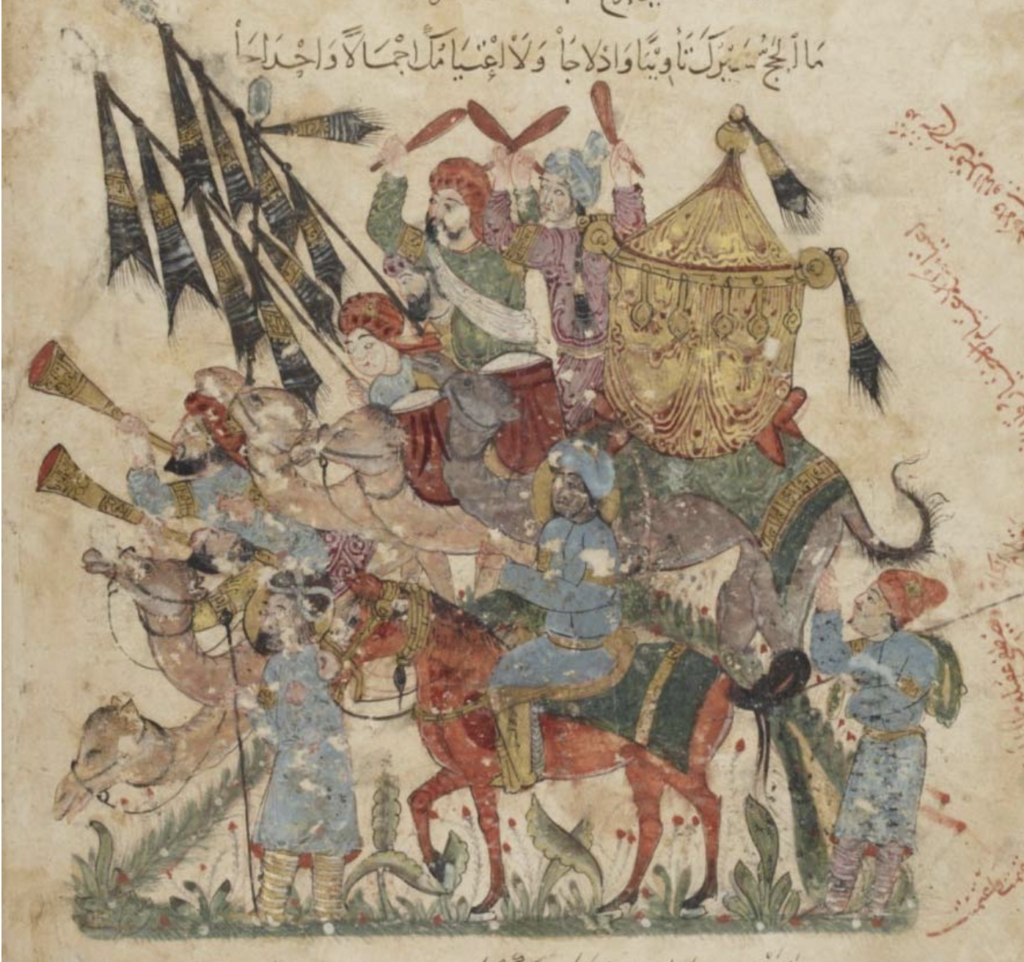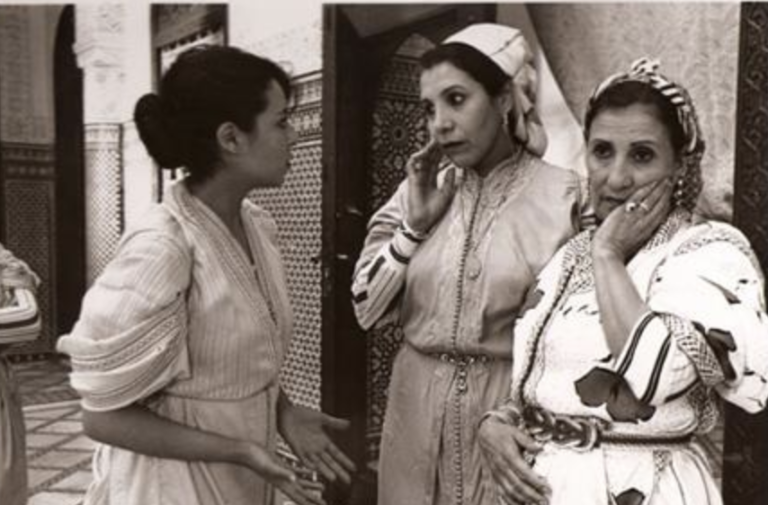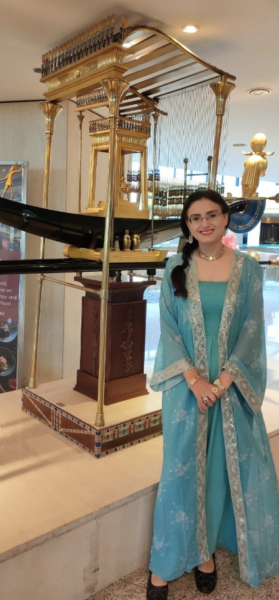Flight of the Camel
This post presents a new translation of an old poem, a qaṣῑda from classical Arabic literature. The poet is Abu Nuwas (who lived c. 757-814), but this is not a typical Abu Nuwas poem. Instead, it provides a nice example of a standard and celebrated praise poem (essential for poets to make a living in this time). Enjoy! PDF copy of this post available here for easy printing or to save for later.

Introduction
By Melanie Magidow
Celebrated most for his wine and love poetry, Abu Nuwas has attained a legendary reputation of buffoonery and libertinism. This praise poem, however, presents another aspect of the poet’s colorful character: his professional skill and ability that gained him so much notoriety among his contemporaries. It was first performed in a city far from the usual settings of his Basran youth, his success at the court of Baghdad, and his escapades at rural monasteries. His path (of uncertain circumstances) led him to the capital of Egypt, where he probably lived between the years of 805 and 807. This was long before Cairo developed into the city we know today. At that time, the administrative center was Al-‘Askar, the Abbasid garrison city built near the older city of Fustat.
This poem praises al-Khasib ibn ‘Abd al-Hamid, the fiscal governor of the time. He had been appointed to this post by the illustrious caliph Harun al-Rashid, who ruled from Baghdad, the capital of the Abbasid dynasty. Abbasid leadership over the Islamic empire held from 750 to 1258, the year of the Mongol invasion of Baghdad. In this poem, Abu Nuwas paints the poetic picture of a journey to al-Khasib in order to praise his new benefactor.
As a madῑḥ, a panegyric in praise of a patron, the poem draws on structural conventions of the genre. The first element of the convention is the nasib (amatory prelude), which does not play a major role in this poem. Indeed, it wasn’t a distinctive part of Abu Nuwas’ panegyric work in general. However, and in this poem especially, Abu Nuwas returns to the tried and true topos of al-raḥῑl (the desert journey). He includes eloquent descriptions of desert fauna, namely the eagle (‘aqanbāt ) and the swift she-camel (sg. hawjā, pl. hῡj). In the panegyric proper, Abu Nuwas praises his patron as a paragon of social virtues.
Commentary
For the purpose of discussion, I’ve divided the poem into six segments:
1. Amatory prelude
The poet addresses a woman who lives nearby. He contemplates getting to know her better, taking a stoic approach to the prospect and the difficulties it would entail. The strength of character he displays complements other themes in the poem, which dwell upon qualities valued in a ruler, such as firmness and authority. The speaker also claims the ability to know inner selves from outer appearances, referring to the highly developed and valued concept of firāsa (discernment).
2. Description of an eagle
The image of the eagle serves to describe the emotional state of the speaker in the poem. In the performance context, it also offers a particularly apt illustration of a ruler with a sharp mind in the position of viewing vast distances. The eagle’s unimpaired vision compliments the ruler’s ability to judge. In contrast to the beautiful strength of an eagle overlooking the melting frost, the poet weaves in the theme of hunger and vulnerability. The purpose of this eulogy is in part to praise the ruler, but it is also (and of at least equal importance) to provoke the ruler’s generosity.
3. Departure scene
Vulnerability colors the poet’s departure from his beloved. He describes her tears and depicts his helplessness. As a poet, he must take to the road to earn his living. His journey leads him from Iraq to Egypt to seek the favor of al-Khasib. As the poet begins to describe his prospective patron, the scene of departure from his beloved gradually fades into the background.
4. Eulogy of patron in combat
Here the standard motif of battle success demonstrates the greatness of the ruler. After the brave conqueror overcomes a population, the captives are humbled, in keeping with legendary and historical notions of power.
5. Call to attention
Now addressing the vizier, the poet recognizes his long experience and competence the, and yet he manages to put the minister in his place, so to speak. Cautioning the vizier to heed his speech, he assures him that the caliph, the “prince of the believers,” is fully a ruler, and knows the quality of his artistry. Like a “straw man,” the poet employs the figure of the vizierto strengthen his speech. In the court performance context, the poet’s reminder that final judgment rests with the caliph fulfills a political design to promote and praise those most able to pay poets.
6. Journey, panegyric, and final appeal
The final movement in this poem is also the longest. It picks up where Part 4 left off, addressing the sovereign.The poet has craftily returned to the theme of his journey in search of fortune, and opens with camels speeding toward the caliph. Their haste to reach a ruler on his throne reflects the earlier image of an eagle sitting on high, just as a ruler would survey his domain. Recalling the vulnerability of hunger in Part 2, the people and camels rushing to their ruler in time of need clearly depict the poet’s own appeal. Likening the camels’ skulls to headstones connotes mortality and need, as well as the passing of this life and its opportunities to show generosity.
The narrative of the poet’s journey includes intricate details regarding locations on the route from Iraq to Egypt, as well as times that indicate the relative distance between locations, demonstrating the poet’s actual knowledge of travel. (There are a few unclear details left unexplained in the translation. For example, Wagner interprets al-bayt al-muqaddas, ‘Jerusalem,’ as the road in Egypt that led toward Jerusalem. We have simply translated it as it appears in the text.) As the poet maps his journey, he elaborates upon the theme of endurance that M.C. Lyons has identified as central to classical Arabic poetry. In times of war, endurance entails loyalty and determination. In times of peace, endurance takes the shape of a rugged journey (Lyons 30). This poem combines a search for fortune with a recognition that nothing (especially money) lasts interminably. The journey serves as a device employed by the poet to “underline the breadth of the poet’s experience,” and thus to strengthen his appeal while entertaining his prospective patron (Lyons 29).
Just as the poet compared the ruler with an eagle, the camels may represent his subjects’ eagerness to gain his presence. Their extraordinary resilience and endurance also fit with the general tenor of this poem that celebrates the struggle and success of travel and battle that one might expect a ruler to appreciate. Their arrival in Fustat, and the protection they receive, indicates the end of their journey, the end of the poem, and the end of this attempt to win patronage with poetry. The poet honors his prospective patron with a description encompassing many traditional values of kingship: authority, generosity, charisma, strength, justice, and honor. In addition, the poet traces the caliph’s lineage to non-Arabic speakers (Persians) and depicts them as gracious hosts. (It is uncertain if Abu Nuwas was particularly sympathetic to Persians, but his mother was Persian, and Persian and Arabic cultures were closely entwined at this time).
Reception
Abu Nuwas completes the eulogy by acknowledging the caliph’s judgment regarding his art. No record remains (to my knowledge) to indicate whether or not al-Khaṣῑb was pleased. Yet Ibn al-Mu‘tazz (861-908) introduces the poem in his Ṭabaqāt al-shu‘arā’ as a good poem, known by many. (Ibn al-Mu‘tazz 211). That this eulogy was widespread in Abu Nuwas’ own day indicates its ability to please people, perhaps to serve as an exemplary praise poem, as well as Abu Nuwas’ competence and adaptability to a variety of circumstances. Clearly, he could be very dignified when the occasion called for it.
Translation
By Melanie Magidow and Kevin Blankinship
Meter: ṭawīl. For Arabic source text, see Wagner (poem no. 34, p. 244-252). Also available online here.
(Part 1)
O Lady, neighbor to our home and kin of our house, your father is zealous to guard you;
What’s difficult for you is easily done.
If you won’t be a friend (a wife),
Then may veils conceal you from me
You live near a people held back by bad blood from visiting and keeping in touch,
To the Day when the dead will rise and disperse.
I’m not struck and dazed by passion [like others];
Love is no Sultan overpowering me
Just by looking, I can read another’s thoughts
As if no recesses of the mind could hide from me—
(Part 2)
My perception is keen like that of
A taloned eagle protecting its young.
Two nights have passed without food for the needy,
The down-covered eaglet has yet to grow its first feathers
[The eagle] observes on high until there appears to her
The first sliver of sun, frost and ice melting away
She surveys the scene, her eyes turning
With unimpaired vision.
(Part 3)
Says the woman from whose home my caravan departed:
It’s hard to see you go.
Can’t you seek fortune somewhere nearer than Egypt?
Certainly the places for fortune are many.
I replied, as sudden tears overcame her,
The teardrops falling, her perfume in their wake,
Let me make even more people jealous of you by going [to seek fortune for you]
In a land where al-Khaṣῑb commands!
If my mounts don’t visit the land of al-Khaṣῑb,
From who else could I make my fortune?
He values generous compensation for deserving praise,
Knowing that ephemeral things are fleeting.
Generosity does not pass him by or go on without him;
Rather, it goes where he goes.
My eye sees no authority like his,
It comes and goes with him, in all he undertakes.
(Part 4)
Like snakes, the nobles of this land grovel
As the viper of stern Khaṣībian resolve passes.
You conquered the Egyptians of Ḥawf on their home field,
Turning them into captives in shackles:
Whenever one stood, there jingled upon his leg a trinket
That would permit only short steps through the courtyard.
(Part 5)
For any who remain ignorant of my speech,
The commander of the faithful knows fully [and can edify any lacking understanding!]
You [vizier], have ever counseled him since he was a youth,
Until the first gray hairs appeared around his face.
When trouble seized him unawares, you protected him,
Or knew where to refer him.
(Part 6)
To you the swift camels bolted, carrying their riders,
Their skulls straining forward like curving headstones.
They bore us from the town of ‘Aqraqūf as the sun rose,
The crack of dawn appearing in the morning, striking and clear.
They did not even begin to sweat until I saw them
Enter the valley of ‘Aynay Ubāgh with the setting sun
They drank deeply from the water of Nuqayb
As the cock crowed.
We came to the temples of Tadmur at sunrise,
Heading toward the height of al-Mudakhkhin.
The camels rushed to the people of al-Ghuṭatayn in Damascus,
As if they were seeking vengeance there.
In the rocky Golan Heights, they crushed the very stones,
Their bodies now showing their suffering.
They endured a night without shelter near the town of Baysān,
The light of morning scarcely appearing to the onlookers.
They crossed the desert at the river of Fuṭrus,
Coming to al-Bayt al-Muqaddas [Jerusalem].
The riders made for Gaza, where lies Hāshim, the Prophet’s grandfather,
Grieving from their need at the great waystation of Faramā.
When they came to Fustat, a guardian protected them,
Ordering that they not be dishonored,
Beaming as if his brow were
The brilliance of dawn, its glow illuminating the night,
[Made proud by] al-Khaṣīb’s sword and spear in times of unrest,
And in peace [made proud by] both pulpit and throne.
He is generous when other hands cease from giving,
Protective of women,
Descended from Persians:
If one asks to enter in times of peace, their faces light up like full moons.
Arriving at your court, I merit the wealth that you give me
And you merit the hopes I have in you.
Your generosity to me proves my merit,
And in any case, I am accepting and grateful.
Translator’s Note from Kevin
I found the first three lines of this poem quoted in Rasāʾil al-intiqād fī naqd al-shiʿr wa-l-shuʿarāʾ by Ibn Sharaf al-Qayrawānī, who supposedly wrote in response to his rival Ibn Rashīq’s al-ʿUmda. Ibn Sharaf blasts Abū Nuwās for a monstrous, coarse nasīb, based on Ibn Sharaf’s understanding that the poet is in fact wishing death on this woman if she won’t be his friend or wife. According to this reading, the “veils” wished upon the woman are veils of dirt, and the “folk” she lives by and who don’t see or talk to each other are dead (which is why they don’t see or talk to each other, nor will they till Judgment Day). I love this reading but it’s not the only one offered by medieval Arabic critics. The translation here doesn’t reflect it.
Sources
Ibn al-Mu‘tazz, ‘Abdullāh. Ṭabaqāt al-shu‘arā’. Cairo: Dār al-Ma‘ārif, 1968.
Lyons, M.C. Identification and Identity in Classical Arabic Poetry. Wiltshire: Gibb Memorial Trust, 1999.
Wagner, Ewald, ed. Der Dῑwān des Abū Nuwās. Vol. 1. Beirut: In Kommission bei “Das Arabische Buch” Berlin, 2001.
Image Source: The Met https://www.metmuseum.org/blogs/ruminations/2016/hajj-camel-snapchat . From Maqamat al-Hariri. Abu Zayd on Hajj and the Caravan of Pilgrimage (Maqama 31, fol. 94v), ca. 1237 A.D. Iraq. Bibliothèque Nationale de France, Arabe 5847
Note
This post is based on a paper written for a graduate seminar with Philip F. Kennedy at New York University in 2006. To learn more about Abu Nuwas, see Kennedy’s Abu Nuwas: A Genius of Poetry (Oxford: Oneworld, 2005).


